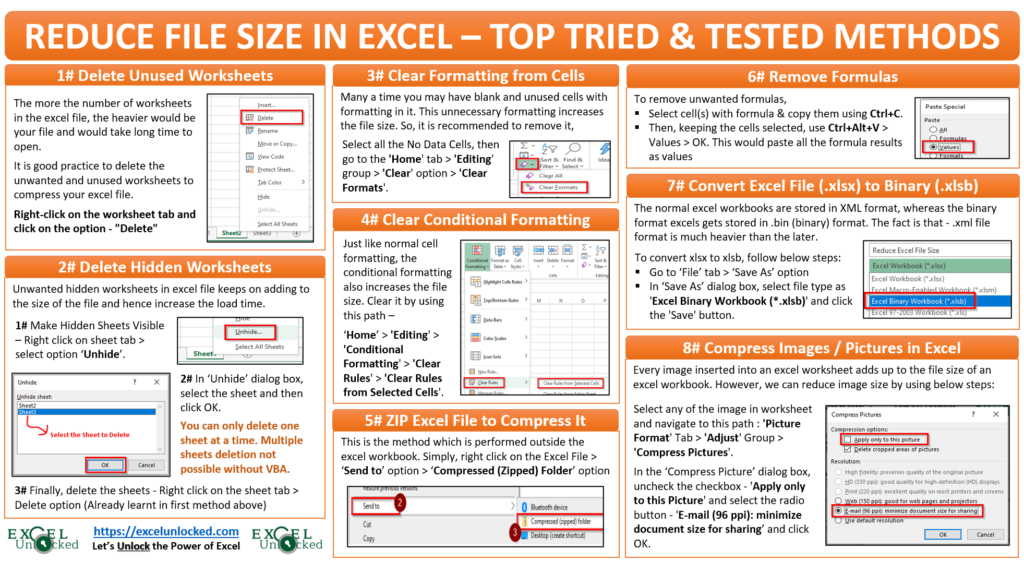5 Ways to Reduce Excel File Size Instantly

Excel Files Are Often Too Large

Large Excel files can be a major headache. They slow down your computer, take up too much storage space, and can be challenging to share or collaborate on. But fear not! There are several straightforward strategies to shrink the size of your Excel workbook quickly. Here are five ways to reduce Excel file size instantly:
1. Remove Unnecessary Data and Formatting

One of the quickest ways to reduce file size is to remove any excess content:
- Delete Empty Rows and Columns: Select the rows or columns you don't need, right-click, and choose Delete. This reduces the file size by removing unnecessary space.
- Clear Formatting: Go to Home tab > Clear > Clear Formats. This will reset all cells to their default formatting, thus saving space.
- Remove Unused Styles: Navigate to Home > Cell Styles. Right-click any style you're not using, then select Delete.
2. Compress Images and Use Efficient Formats

Images significantly contribute to file size. Here's how to handle them:
- Optimize Images: Right-click an image, select Format Picture, then adjust the Compression settings to reduce its size without sacrificing too much quality.
- Use Proper Formats: Save images in formats like JPEG for photographs or PNG for graphics. Use the Insert Picture dialog to compress images on insertion.
📝 Note: While JPEG offers good compression, remember it can lead to loss of quality upon multiple saves. Consider using PNG if you need transparency or higher quality.
3. Eliminate Unused Worksheets

Every extra worksheet in your workbook adds to its size:
- Delete Unused Sheets: Right-click the sheet tab and select Delete. This can instantly reduce the size of your file.
- Use a New Workbook: If only some sheets are needed, copy them into a new workbook to keep the file lean.
4. Excel Options and Settings

Adjusting certain Excel settings can also help:
- Save Without Formatting: Use Save As to choose the Workbook option without formatting to reduce the file size.
- Change Calculation Settings: Go to Formulas > Calculation Options, and set it to Manual. This prevents Excel from recalculating formulas unnecessarily, which can slow things down and increase file size.
- Disable Excel Add-ins: Some add-ins can significantly bloat your file. Go to File > Options > Add-ins to disable any you're not using.
💡 Note: If you are collaborating, make sure to inform others about these changes to avoid confusion or loss of functionality.
5. Utilize External References and Data Connections

Instead of duplicating data across multiple sheets or workbooks, consider:
- Link External Workbooks: Use Formulas > Define Name to create external references to data, reducing the size of your current workbook.
- Power Query: Utilize Excel's Power Query to connect to external data sources, fetch what you need, and leave the rest behind, thus minimizing file size.
By implementing these strategies, you can quickly reduce the size of your Excel files, making them more efficient to work with. A smaller file size means better performance, easier sharing, and less frustration.
Remember, a well-optimized Excel file isn't just about reducing file size; it's also about improving workflow and ensuring that your data remains manageable and accessible. Regularly practicing these steps can keep your spreadsheets from becoming unwieldy and ensure they perform at their best.
Will reducing file size affect my data?

+
Not directly. Techniques like deleting unused sheets or formatting can save space without losing data. However, always backup your work before making significant changes.
Can I automate these size reduction techniques?

+
Yes, you can use VBA (Visual Basic for Applications) to automate many of these processes, such as clearing formatting or deleting empty rows and columns.
What if my Excel file is already optimized?

+
If you’ve already applied these techniques, consider other methods like converting to a different file format (e.g., .xlsb for binary Excel files) or looking for alternative software like Google Sheets for collaboration.



